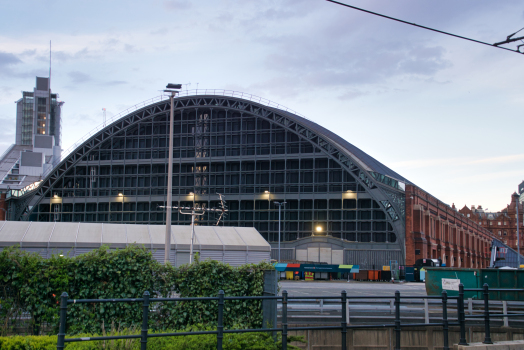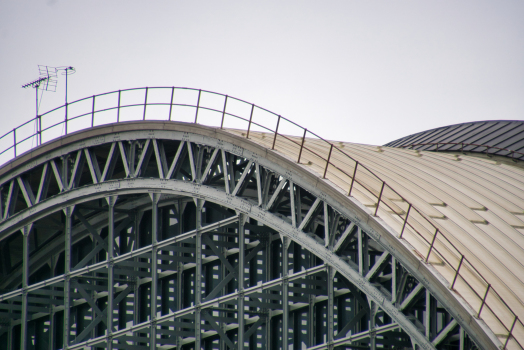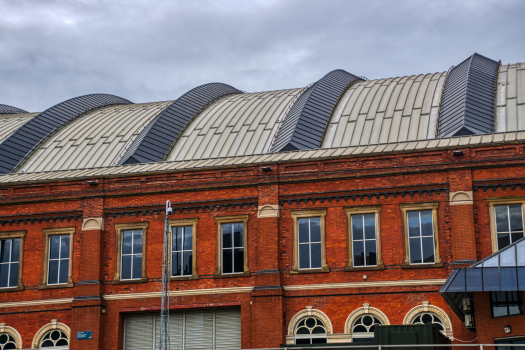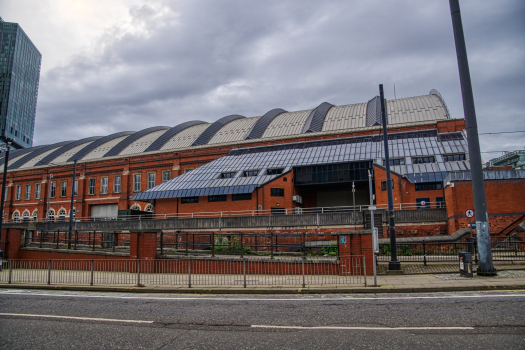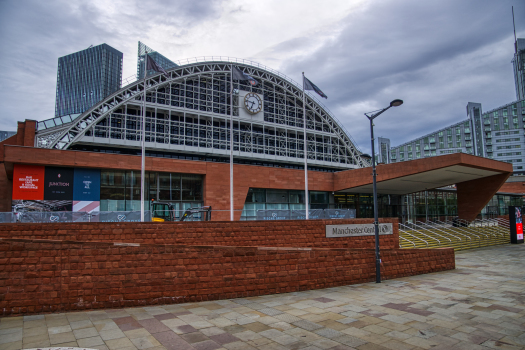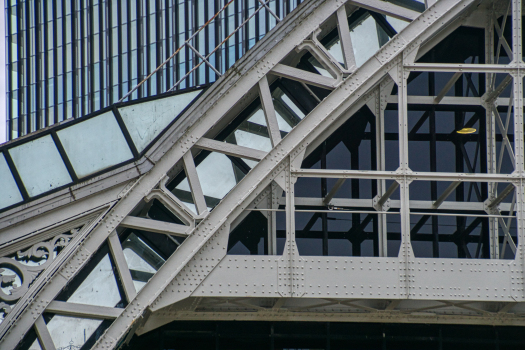General Information
| Other name(s): | Manchester Central Station; Greater Manchester Exhibition Centre (G-MEX) |
|---|---|
| Beginning of works: | 1876 |
| Completion: | July 1880 |
| Status: | in use |
Project Type
| Function / usage: |
Exhibition hall |
|---|---|
| Material: |
Iron structure |
| Function / usage: |
Event venue original use: Railroad (railway) station |
Awards and Distinctions
| 1963 |
for registered users |
|---|
Location
| Location: |
Manchester, Greater Manchester, North West England, England, United Kingdom |
|---|---|
| Coordinates: | 53° 28' 34.12" N 2° 14' 50.83" W |
Technical Information
Dimensions
| track hall | height | 27 m |
| length | 168 m | |
| arch span | 64 m |
Materials
| arches |
wrought iron
|
|---|
Chronology
| 1880 | Manchester Central Station, Used by Midland, Great Northern and Great Central Railways, opens as smaller version of Midland Railway's Saint Pancras Station, London. |
|---|---|
| 1960s | Closed as railway station after having served to the rail line connecting Manchester and Liverpool. |
| 1986 | After a £20 million conversion into an exhibition centre, the building is opened by Queen Elizabeth II. |
Excerpt from Wikipedia
Manchester Central Convention Complex (commonly known as Manchester Central or GMEX (Greater Manchester Exhibition Centre)) is an exhibition and conference centre converted from the former Manchester Central railway station in Manchester, England. The building has a distinctive arched roof with a span of 64 metres (210 ft) – the second-largest railway station roof span in the United Kingdom, and was granted Grade II* listed building status in 1963.
After 89 years as a railway terminus, it closed to passengers in May 1969. It was renovated as an exhibition centre formerly known as the G-Mex Centre in 1982 and was Manchester's primary music concert venue until the construction of the Manchester Arena. After renovation the venue reverted to ist former name Manchester Central in 2007.
From April 2020 until March 2021, the complex became a temporary field hospital for non-critical COVID-19 patients, part of a network of temporary NHS Nightingale Hospitals.
History
Manchester Central railway station
The complex was originally Manchester Central railway station, one of the city's main railway terminals.
Designed by Sir John Fowler, the station was opened in July 1880 by the Cheshire Lines Committee. The station served as the terminus for Midland Railway express trains to London St Pancras. The station's large wrought-iron single-span arched roof, spanning 210 feet (64 m), 550 feet (168 m) long and 90 feet (27 m) high – was a noted piece of railway engineering and is the widest unsupported iron arch in Britain after the Barlow train shed at London St Pancras.
At ist height, in the 1930s, more than 400 trains passed through the station every day. The station operated for 89 years, before closing in May 1969.
GMEX Centre
In 1978, the structure was acquired by Greater Manchester County Council to redevelop as a concert venue. In 1982, construction work was undertaken by Alfred McAlpine. It was the centrepiece of the regeneration plan for the area and wider Castlefield district. The hall covered 10,000 m² (110,000 sq ft) and could be partitioned into various sized units for different exhibitions. Initial construction work concentrated on repairing the derelict structure and re-pointing brickwork which took 18 months. The Greater Manchester Exhibition Centre or G-Mex Centre was opened by Queen Elizabeth II in 1986 after four years of renovation.
In 2001, the Manchester International Convention Centre (MICC) was added, comprising an 804-seat auditorium and breakout rooms and the Great Northern Hall. In 2005, the company running the complex was bought by Manchester City Council. G-Mex was Manchester's primary concert venue from 1986 to 1995. Ist position as a concert venue diminished after the opening of the Manchester (then NYNEX) Arena in 1995.
Manchester Central
In January 2007, the venue was renamed Manchester Central, evoking the memory of the former station and converted into an exhibition and conference centre. The building was renovated at a cost of £30 million in 2008 by Manchester-based architects, Stephenson Bell. The first phase to create a foyer took from February to November 2008.
The second phase, completed towards the end of 2009, included an extended foyer to the Grade II listed Central Hall. The old smoked-glass structure was demolished and replaced by a flat-roofed, clear-glazed structure exposing more of the original architecture. The final phase, completed in September 2010, focused on the rear of the building. New event spaces were built and rooms refurbished to increase the venue's range and size of meeting and banqueting spaces.
Transport
Located in the heart of the city, Manchester Central is served by two Metrolink tram stops – Deansgate-Castlefield tram stop and St Peter's Square tram stop, both of which are under a five-minute walk from the venue. National Rail local train services serve Deansgate railway station whilst Manchester Piccadilly is a 20 minute walk away.
Emergency hospital
On 27 March 2020, the UK government announced that the building would be converted into an emergency hospital, part of a network of NHS Nightingale Hospitals similar to the NHS Nightingale Hospital London that was already under construction, intended to deal with the COVID-19 pandemic and with 1,000 beds. It opened on 17 April 2020, and was closed in March 2021.
Text imported from Wikipedia article "Manchester Central Convention Complex" and modified on April 23, 2024 according to the CC-BY-SA 4.0 International license.
Manchester Central railway station was a railway station in Manchester city centre, England. One of Manchester's main railway terminals between 1880 and 1969, the building was converted into an exhibition and conference centre which was opened in 1986, originally known as G-MEX, but now named Manchester Central. The structure is a Grade II* listed building.
On 27 March 2020, the UK government announced that the building would be converted into an emergency hospital, intended to deal with the COVID-19 pandemic and with 1,000 beds. It was opened in April 2020 and closed in March 2021.
History
The station was built between 1875 and 1880 by the Cheshire Lines Committee (CLC), and was officially opened on 1 July 1880. The architect was Sir John Fowler and the engineers were Richard Johnson, Andrew Johnston and Charles Sacré for the three companies which formed the CLC.
While it was being built, a temporary facility, Manchester Free Trade Hall Station (after the Free Trade Hall a landmark building nearby) was in use from 9 September 1877. It had two wooden platforms serving four tracks. When the station opened, the temporary station became Manchester Central Goods.
In 1963, the building was Grade II* listed for ist special architectural or historic interest.
Construction details
The station's roof is a single span wrought iron truss structure 550 feet (168 m) long with a span of 210 feet (64 m), and was 90 feet (27 m) high at ist apex above the railtracks. Glass covered the middle section, timber (inside) and slate (outside) covered the outer quarters. The end screens were glazed with timber boarding surrounding the outer edges. It was constructed by Andrew Handyside and Co. The substructure and masonry partition were provided by Robert Neill and Sons of Manchester. Underneath the train shed is a large brick undercroft with intersecting tunnel vaults, above which were six platforms above street level which exited the station onto viaducts and bridges. The undercroft was used for storage and connected to the adjacent goods sidings by a carriage lift. The station's two-storey south wall has 15 bays separated by brick pilasters. At ground-floor level the bays have three round-headed windows and at first-floor level three square-headed. In the 20th century a glazed canopy was erected at the entrance at north end.
A temporary wooden building, erected at the front of the station to house ticket offices and waiting rooms was planned to be replaced by a grander edifice, for example a hotel and railway offices as at London St Pancras, but remained in use until the station closed. The Midland Hotel was built by the Midland Railway in 1898–1903 on an adjacent site.
Railway usage
The Midland Railway (MR), one of the CLC's partners, used Manchester Central as ist terminus for services including express trains to London St Pancras. Beginning in 1938, the London, Midland and Scottish Railway (successor to the MR) ran two prestige expresses, The Peaks and the Palatine, stopping en route at Chinley, Millers Dale, Matlock, Derby and Leicester.
Between 1960 and 15 April 1966, during the electrification of the West Coast Main Line, Central Station was the terminus for the Midland Pullman, a streamlined blue six-coach diesel multiple unit. This stopped at Cheadle Heath (now closed), before running fast to St Pancras.
Services through Millers Dale finished in July 1968, when the line was closed as a through route. The station provided local services to Chester and Liverpool, but closed to passengers on 5 May 1969, when the remaining services were switched to Manchester Oxford Road and Manchester Piccadilly stations.
Post-railway era
Dereliction and redevelopment
Over a decade, Central Station fell into a dilapidated state, was damaged by fire and was used as a car park. The property was acquired by Greater Manchester Council and, in 1982, work began on converting it into an exhibition centre, which opened in 1986 as the Greater Manchester Exhibition and Conference Centre or G-Mex. It was subsequently renamed Manchester Central, in honour of ist railway history. The undercroft was converted into a car park, serving the centre and Bridgewater Hall.
Light rail
The opening, in 1992, of the Metrolink light rail system has seen the conversion of suburban heavy rail lines such as the former Manchester, South Junction and Altrincham Railway to Altrincham and the disused Cheshire Lines Committee route via Didsbury. With the introduction of Metrolink, rail services from south Manchester ran once more to Central Station. However, instead of trains running into the Central Station arch, light rail vehicles now cross the railway viaduct and stop at Deansgate-Castlefield tram stop. They then run down a ramp which runs parallel to Lower Mosley Street, alongside the south-eastern side of the former train shed, before reaching street level where they operate as trams and head towards St Peter's Square.
Text imported from Wikipedia article "Manchester Central railway station" and modified on April 23, 2024 according to the CC-BY-SA 4.0 International license.
Participants
- Sir John Fowler (designer)
Relevant Web Sites
Relevant Publications
- Roof of the new Central Station, Manchester. In: The Engineer, v. 49 ( 1880), pp. 124, 163-164, 176.
- About this
data sheet - Structure-ID
20017486 - Published on:
22/08/2005 - Last updated on:
22/04/2024

